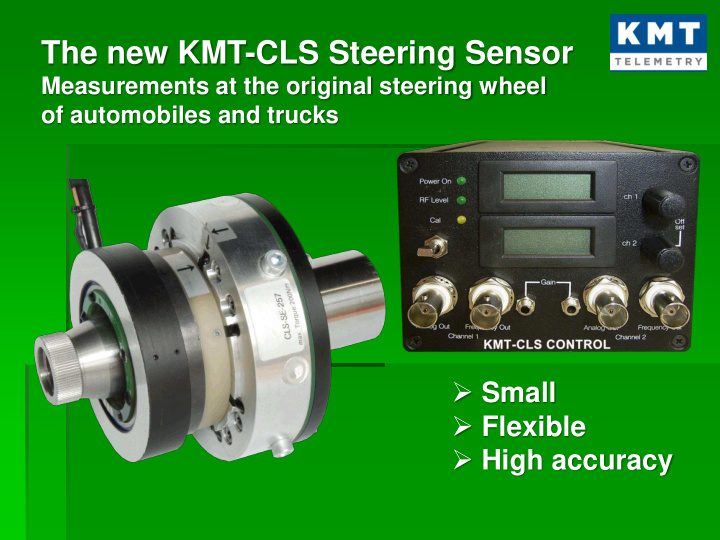



The new KMT-CLS Steering Sensor Measurements at the original steering wheel of automobiles and trucks Small Flexible High accuracy
Structure Development targets Configuration Installation Measurement technique Security Conclusion
1. Development targets
1. Development targets Maintained of the full functionality of the standard steering wheel Easy for mounting Minimum effects on measurement High accuracy
2. Configuration: A modular solution! Easy for mounting
2. Configuration : An integrated solution! Tight design Easy to mount Flexible application
3. Installation: Adapter Adapter we can deliver: Either blank adapter for manufacturing the special toothing by yourself or by ourself then we need exactly drawings
3. Installation : Through connection At the soldering pads Soldering pads at the upper side you can transfer up to 6 signals e.g. : • power supply • Airbag • Lin bus • … Soldering pads at the lower side The contacts you can use up to 4 Ampere
3. Installation : Mounting Steering Column Fit the adapter
3. Installation : Mounting Sensor Fit the sensor and tighten the central screw
3. Installation : Mounting Steering adapter Fit the adapter and tighten the screws
3. Installation : Mounting angle encoder Fit the angle encoder and tighten the screws Fixing of the torque bearing
3. Installation : Mounting Steering wheel Tighten the steering wheel and the central screws Mounting of the impact plate incl. Airbag Ready for take off!
4. Measuring: What kind of technique? Steering torque: Sensor integrated strain gage application: temperature compensated Measurement range: Nm 100 or 200 (choose when you order) Accuracy: % FS 0,2 Bandwidth: DC ... 800 Hz Direction of rotation: positive torque clockwise Temperature drift: max. 0.004% FS/°K Angle sensor: Sensor type: incremental magnetic sensor Angle resolution: 0.04° (8800 steps/360°)
4. Measuring: The Control Unit Common Dimensions: ca. 80mm x 105mm x 185mm Weight: 1,15 kg Temperature range: - 20°C ... + 80°C Power supply: 9 ... 36 V/DC
4. Measuring: CAN-Bus Interface Electrical interface: ISO/DIN 11898 incl. galvanic isolation Configuration: at CAN by using CCP-protocols, the identification is raised by serial number Baud rate: 10 kBaud ... 1 MBaud configurable by software Identifier: 11 bit oder 29 bit free configurable Message configuration: free configurable Update rate: max. 5000 Hz, divisible be configurable, integer factor Torque range: ± 100 Nm or ± 200 Nm depending of the type Torque resolution: 16 bit (0,003 Nm or 0,006 Nm) Rotation angle range: ± 1340° Rotation angle resolution: 16 bit : 0,04° (8800 steps/360°) Rotation speed: ± 1000°/sec Rotation speed resolution: 16 bit
4. Measuring: Analogue Outputs Output voltage: ± 10 V Analogue offset balance: by rotary potentiometer at the front plate Bandwidth: 0 ... 800 Hz Torque range: ± 100 Nm or ± 200 Nm as the type may be Torque resolution: 12 bit (0,049 Nm or 0,098 Nm as the type may be) Rotation angle channel: ± 1000° (= ± 10 V) Rotation angle resolution: 0,65° Steering Torque Display (Nm) Analog Offset Trim for Steering Torque Rotation Angle Autozero Button Display (degrees) Activate only CAN Interface Not active for analog output! Analog Offset Trim Only for factory setting! For Steering Angle Analogue output Frequency output Analogue output Out off function! for steering torque for steering torque for steering angle
4. Measuring: What kind of technique? Frequence output for torque Type: 5 V TTL - rectangle signal Frequency range: 10000 Hz ± 5000 Hz 5000 Hz = - 100 Nm or - 200 Nm 10000 Hz = 0 Nm 15000 Hz = + 100 Nm or + 200 Nm Digital display Torque display: ± 100 Nm or ± 200 Nm for direct reading Torque display resolution: 0,1 Nm Rotation angle display: ± 1000° for direct reading Rotation angle display resolution: 1°
4. Measuring: Configuration
5. Security - Airbag will be full in function - Test driver will not be influenced by the measuring - All functions of the standard steering wheel you can use without constrictions - Mechanical fracture torque > 500 Nm - Additional mechanical protection against breakage is integrated
6. Conclusion - Very fast integration in a test vehicle - You can use the complete functionality of the standard steering wheel - You can use the CLS in nearly all kinds of vehicles (cars, trucks, tractors, military …) - Optimal signal resolution - Minimum effects on measurement The new steering sensor – a fantastic solution!
Thank you for your attention! KMT- Kraus Messtechnik GmbH Martin Kraus – Sales Manager Gewerbering 9 D-83624 Otterfing - Germany Tel. +49-8024-48737 Fax +49-8024-5532 Email: info@kmt-telemety.com Web: www.kmt-telemetry.com
Recommend
More recommend